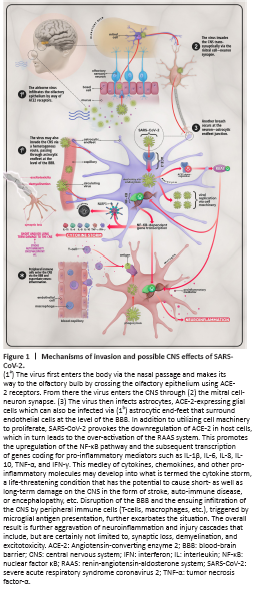神经损伤与修复
-
Figure 1|Mechanisms of invasion and possible CNS effects of SARS-CoV-2.

The above mechanisms exhibit a complex interplay as they loop into one another leading to the neurological manifestations seen in COVID-19. This interplay makes the distinction between the direct and indirect effects of SARS-CoV-2 unclear. Assuming successful entry of the virus into brain tissue, its interaction with the ACE-2 receptor would activate a cascade of events leading to the cytokine storm. In this regard, overactivation of RAAS, acting through ACE/Ang-II/AT1R arm, can induce inflammation through profibrotic cytokines like TGF-β (Mahmudpour et al., 2020). As it has been eluted to earlier, SARS-CoV-2 can lead to downregulation of ACE-2 causing a reduction of Ang (1–7) production and as a result removal of the brake on the ACE/Ang-II/AT1R signaling leading to uncontrolled hyperactivation of the RAAS system. As a result, the NF-κB pathway is activated leading to elevated production of proinflammatory cytokines IL-6, TNFα, IL-1β, and IL-10 (Pacurari et al., 2014; Mahmudpour et al., 2020). The release of these molecules and their accumulation in the serum leads to cytokine storm and eventually to acute respiratory distress syndrome (ARDS) in severe cases (Figure 1) (Mahmudpour et al., 2020).